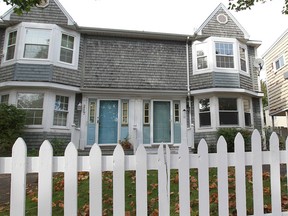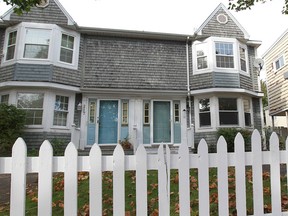Reports of a ‘mortgage renewal cliff’ have been greatly exaggerated

It’s high time to dial down the drama

Article content
Few real estate stories have had more hype in the last year than the dreaded mortgage renewal shock, a.k.a. “mortgage renewal cliff,” “mortgage renewal wall,” or whatever other ominous-sounding metaphor commentators came up with.
Horrific predictions of 60 per cent payment increases made headlines, while the bank regulator warned a tidal wave of mortgages (three-quarters of all mortgages) would come up for renewal by year-end 2026. Countless economists threw in their two cents, with RBC predicting $275 billion of renewals next year alone.
Advertisement 2
Article content
It’s high time to dial down the drama. Here are six reasons why the mortgage renewal “wall” will probably be a knee-high picket fence — at least for most people.
Borrowers were pre-tested
Getting a prime mortgage in Canada comes with a pop quiz: can you handle a rate at least two percentage points above your actual? That’s the government’s stress test.
Flashback to five years ago: folks snagging mortgages at 2.50 per cent had to prove they could manage payments at rates around 5.19 per cent. Fast forward, and today’s fixed-rate renewers are coasting in at just 4.29 to 4.99 per cent. So, we’re not just talking about mortgagors passing the test; they’re scoring extra credit.
Payments aren’t double
Rates may have doubled, but mortgage payments surely haven’t followed suit.
On the average mortgage, which is about $300,000 in Canada, going from 2.5 per cent to five per cent after five years boosts one’s payment by 29 per cent ($353 per month). And, it can be much lower if the remaining amortization is less.
That is no doubt still a lot for many families suffering under Canada’s burdensome cost of living. Many folks with strained budgets will renegotiate into a longer amortization to trim payments. And even if they don’t qualify for a full refinance, our trusty government has made it more possible than ever to request payment relief from their bank.
Article content
Advertisement 3
Article content
And then there’s the next important point.
Incomes keep ascending
Mortgagors living in a dual-income household, who work 40 hours a week at the average hourly wage, make a combined income of roughly $154,000 a year. That’s up $29,000, or 23 per cent, from when they would have signed their mortgage five years ago. Even after inflation and taxes take their pound of flesh, this added income softens or even neutralizes the sting of higher mortgage payments. And so far, job losses among homeowners have been modest.
Rates should keep getting better
If the bond market’s forward rate projections roughly pan out, renewals should only get easier. Markets now imply variable rates will be approximately 150 bps lower 12 months from now, and five-year fixed rates about 44 bps lower. This optimistic scenario springs from the forward rate outlook as tracked by CanDeal DNA. It also assumes banks keep their markups as is. Hence, it’s a semi-safe bet that better days are ahead for borrowers.
Borrowers will try to surf rates lower
Many folks will renew into an adjustable-rate mortgage (ARM) or short term, with hopes their payments float down as Canada’s benchmark prime rate drops. A standard new non-default-insured $500,000 ARM would set you back around $1,756 a month at today’s best rate. If rates ease 150 bps by next August as the market expects, that payment will drop more than $400 a month.
Advertisement 4
Article content
It’s not most borrower’s first rodeo
The majority of borrowers aren’t new to the high-stakes game of “Keep My Roof Over My Head.” As Kevin Fettig, President of CMI Financial Group, pointed out, “Most borrowers are not facing their first rate reset — they will renew their mortgage five or more times over a 25-year amortization period.”
He adds, “Many have already dealt with rates higher than the pandemic lows.” So, they’ve been around the block, maybe even thrice.
All this said, the minority renewing for the first time will have more of a challenge. So will non-prime borrowers who typically renew more quickly (in one or two years) and at much higher rates (at least 100 to 300 bps higher). That’s why we’re seeing a small surge in default rates in the institutional non-prime market. But for perspective, it’s not even in the same postal code as what we saw during the Global Financial Crisis.
Suffice it to say, Canada’s mortgage market will weather the renewal storm well enough, barring rates running back near the 2023 highs — and yes, that’s possible, but with accelerating joblessness and decelerating inflation, not probable.
Advertisement 5
Article content
Robert McLister is a mortgage strategist, interest rate analyst and editor of MortgageLogic.news. You can follow him on X at @RobMcLister.
Bookmark our website and support our journalism: Don’t miss the business news you need to know — add financialpost.com to your bookmarks and sign up for our newsletters here.
Mortgage rates
The rates displayed below are updated by the end of each day and are sourced from the Canadian Mortgage Rate Survey produced by MortgageLogic.news. Postmedia and Imaginative. Online Inc., parent of MortgageLogic.news, are compensated by certain mortgage providers when you click on their links in the charts.
Click on the button to load the content from flo.uri.sh.
Click on the button to load the content from flo.uri.sh.
Click on the button to load the content from flo.uri.sh.
Article content

